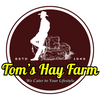Spring has arrived at Tom’s Hay Farm, and while we’re tending our fields, a major water project up north is grabbing attention. California’s $20 billion Delta Tunnel plan, prominent in March 2025 news, is sparking debate about water distribution across the state. It’s a significant issue for agriculture, and here in the Imperial Valley, we’re considering what it might mean for our hay production and your livestock needs.
The Delta Tunnel aims to improve how water moves from the Sacramento River southward. Currently, aging pumps draw water from the Sacramento-San Joaquin Delta, but they’re unreliable—prone to breakdowns, harmful to fish, and disrupted by storms. The proposal involves constructing a 45-mile tunnel beneath the Delta to deliver water directly to farms and cities, ensuring a more consistent supply during droughts or earthquakes. It’s a large-scale effort to support California’s irrigation, though it’s not without controversy.
Support for the tunnel comes from Central Valley farmers growing crops like almonds and grapes, who see it as a way to secure steady water regardless of weather conditions. Urban areas like Los Angeles also favor it, anticipating a larger share. However, smaller Delta-region farmers oppose it, fearing reduced water for their fields or damage to local fishing. Environmental groups argue it threatens wildlife, and many taxpayers question the high cost. The divide reflects differing priorities across the state.
If approved, construction could begin around 2026, pending resolution of ongoing disputes. Completing a 45-mile tunnel is no small task—estimates suggest 10 to 15 years, given the project’s scale and the decades-long discussions preceding it. The timeline remains uncertain, as approvals and funding are still under negotiation. For now, it’s a plan in progress, with years before water might flow through it.
Here in the Imperial Valley, the tunnel’s impact on Tom’s Hay Farm is limited. Our water comes from the Colorado River, managed by the Imperial Irrigation District with rights to 3.1 million acre-feet annually—not from the Delta system. This keeps our hay production stable for your animals, regardless of northern changes.



